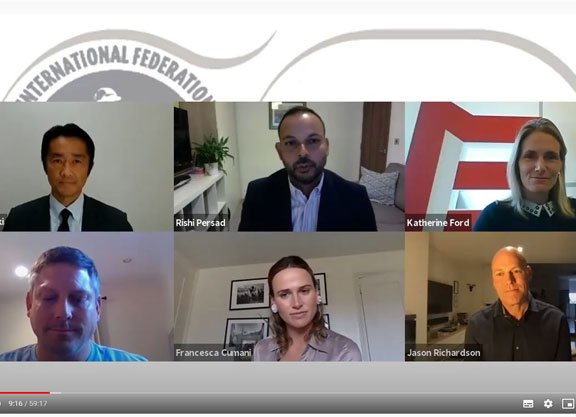By Kelsey Riley
The emergence of unexpected creative opportunities and the near universal cooperation and enthusiasm of racing's participants to produce a quality product were among the common themes discussed by racing media personalities in the UK, France, U.S., Australia and Japan during the second panel of the International Conference of Horseracing Authorities. Entitled 'Adapting the Broadcast, Production, and Media Experience to a COVID-19 Racing and Sporting Landscape,' the panel is part of a series of videos produced by the International Federation of Horseracing Authorities in a virtual format of its conference annually held in Paris the day after the G1 Prix de l'Arc de Triomphe.
While each of the panelists-Francesca Cumani of ITV, Equidia/Sky Sports Racing's Katherine Ford, Shigeru Suzuki from the Japan Racing Association, Jason Richardson of Channel 7 and Racing.com in Australia and Rob Hyland of NBC Sports in the U.S.-acknowledged that having a vibrant crowd on course is always preferable, they admitted that the need to get more creative with production to fill that void has had unexpected positive consequences.
“It's made the industry modernize quite dramatically,” said Cumani. “We've been behind in England in terms of trainers doing video updates for their owners or jockeys informing people at home. Oisin Murphy and Tom Marquand, for example, have been widely praised for their in-car video updates. Anything we can do to engage audiences is great, and especially getting those personalities to realize the power they've got-people want to hear from them.”
Richardson noted how Australians have gotten behind broadcast production.
“Normally if you asked a group of owners to film themselves watching a race there's no chance they would,” he said. “But now in this COVID situation they've been happy to film themselves or set up Zoom parties.”
“Another thing that's been successful is actually starting to get the participants to speak with each other,” he added. “We're very restricted in regards to access, so suddenly a jockey interviewing a jockey is showing the various personalities.
“With some of our magazine programs we're able to Zoom into all the various trainers' and jockeys' houses and we've actually got better access than we normally would. For example we do a number of shows where we're Zooming from Melbourne Cup-winning trainer Danny O'Brien's property down in Geelong and the very next segment we're Zooming from Newmarket with Charlie Fellowes talking about Prince of Arran. In the past I'm not sure we would have tried that because we would have been really concerned about the quality of the vision and sound, but now everyone is accepting that it's ok.”
Hyland described how his production team has managed to stay up close and personal-perhaps moreso than ever-despite being off-site.
“The things we've leaned hardest into are just a lot more access,” he said. “We've added a lot more microphones to jockeys. We've had the ability for the outrider after the race to have a speaker on his gear so that Jerry Bailey, our Hall of Fame jockey, can actually interview the winning jockey from his home in Fort Lauderdale. We've brought a lot of technology to the table that's really helped bring the spectators close to the action.”
Ford noted that the pandemic seemed to have made horsemen in France more aware of their responsibilities to the public as they resumed after a hiatus in the spring.
“They [horsemen] were all very positive when racing started back again on giving news about the horses,” she said. “I think there was a general raising of the consciousness that we're no longer in this kind of cocoon where we train the horses in the morning, we go to the races, we try to give as little information as possible, have a glass of champagne and then go home. We've realized that everyone is in this together and we're all trying to give the sport a positive image and keep it going and improving.”
Ford described the delicate process of resuming racing while large segments of the population remained under lockdown.
“In France, racing-apart from the big events like the Prix de l'Arc de Triomphe-doesn't have that public sympathy and it doesn't have as much popularity as it does say in Britain, Australia and the States,” Ford said. “So we really felt we had to use this opportunity to show that we were being perfect and that we were respecting the rules. We had to make sure that everyone had their masks on and that our producers and camera crew knew not to film anyone that had taken their mask off to have a drink or a cigarette or the mask wasn't covering their nose. To be honest we've not had any problems with that in particular, but we definitely had this feeling that we had to show ourselves off in the best possible way because there would be more people watching racing who don't normally watch racing.”
Each of the panelists acknowledged the opportunities presented by the pandemic in drawing new audiences to racing, and the challenges ahead to maintain them.
“When the pandemic hit, our programming department at NBC Sports really leaned hard into the fact that this was really the only sport up and running in the United States and for the betting public it was a giant opportunity,” Hyland said. “We formed a partnership with 24-hour horse racing network, TVG, and put block programming on and saw really good numbers. The opportunity is to keep those viewers and harder-core bettors involved for the long run. I think this whole process has taught us that we can really look toward a new audience and try to bring them with us in the future.”
Not a subscriber? Click here to sign up for the daily PDF or alerts.






